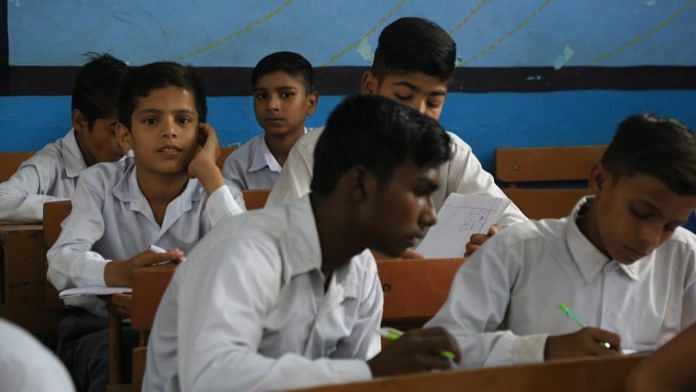
New Delhi: Only 8 per cent of a total 4,81,91,351 children from minority communities, aged between 5 and 15, attend schools for minority communities, a report by the National Council for Protection of Child Rights (NCPCR) has found.
Furthermore, just over 37 per cent (38,44,074) of students enrolled in these schools belong to minority communities, with non-minority groups making up the majority of the student population.
For the report, released Tuesday, the NCPCR conducted a nation-wide survey of schools catering to Muslims, Christians, Jains, Sikh, Buddhist, Parsis and other linguistic minorities including madrasas.
Titled ‘Impact of exemption under Article 15 (5) w.r.t Article 21A of the Constitution of India on education of children of the minority communities’, the report analysed data from 23,487 minority schools across the country, followed by discussions with experts.
“It is pertinent to note that Article 15(5) empowers the government to form any policy for the upliftment of socially backward class, thus forming the basis of affirmative action in private unaided schools in India. However, since it has been made inapplicable to minority schools along with the RTE Act (Article 21A), the study aimed to understand the impact of their exemption on the children,” the report said.
After this survey, the NCPCR has recommended that all such schools, including madrasas, should be brought under the purview of Article 21A and the Sarva Shiksha Abhiyaan — a flagship government programme aimed at ensuring universal access to education.
The council also noted that all unrecognised institutions should be mapped and students who are part of these schools should be included in the ‘out of school children’ category.
According to the report, unrecognised institutions refer to unrecognised madrasas, Vedic Pathshalas, Gumpas and other forms of non-formal education centres.
More non-minorities in minority schools
The NCPCR report looked at the enrollment data of these minority schools and noted that 62.50 per cent or 64,07,070 students from non-minority communities attend these schools.
It added that Jain community schools have the highest percentage of non-minority population, 81.41 per cent, among their minority schools. Meanwhile, the Muslim community schools have the lowest percentages of non-minority population, 20.29 per cent, among their minority schools.
The Christian schools have 74.01 per cent non-Christians in their schools while in Sikh schools, a total of 75.50 per cent students are non-Sikhs.
The report also highlighted that the Christian community in India, which makes up a total 11.54 per cent of the religious minority population, has a 71.96 per cent share of the total religious minority schools in India.
Meanwhile, the Muslim community makes up 69.18 per cent of the country’s religious minority population but contributed 22.75 per cent to minority schools.
The report also noted that in 2015-16, 1.1 crore Muslim children were out of school.
The NCPCR further asked for a greater role of National Council for Educational Research and Training (NCERT) and State Councils for Education Research and Training (SCERTs) to “take the fundamental right to elementary education to all children, especially children of minority communities”.
(Edited by Rachel John)
Subscribe to our channels on YouTube & Telegram
Why news media is in crisis & How you can fix it
India needs free, fair, non-hyphenated and questioning journalism even more as it faces multiple crises.
But the news media is in a crisis of its own. There have been brutal layoffs and pay-cuts. The best of journalism is shrinking, yielding to crude prime-time spectacle.
ThePrint has the finest young reporters, columnists and editors working for it. Sustaining journalism of this quality needs smart and thinking people like you to pay for it. Whether you live in India or overseas, you can do it here.